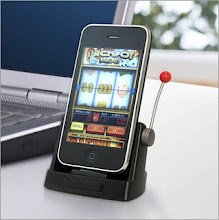The touch screen revolution is upon us. From the Apple iPad, to Android cell phones, to Microsoft's brilliant Surface table, multi-touch interfaces have given us the power to control computers with simple hand gestures in ways that were mere science fiction just a few years ago.
Thanks to recent technological advances, touch screens are only now becoming mainstream. But the idea is nothing new. Think of the old pen-based graphics tablets for the Atari 800 and Apple IIe in the 1980s, or early stylus-based handhelds like the Apple Newton and the PalmPilot in the 1990s. Those latter devices contained pressure-sensitive resistive screens, which consisted of two separate layers and worked best with a plastic or metal stylus.
Contrast that to today's Apple iPad and the Motorola Droid X, which feature large, single-layer, glass capacitive touch screens. Capacitive screens allow for greater control than what you'd find on an ATM or older car navigation system. They respond accurately to the lightest fingertip touches, and support multi-touch gestures like two-finger zoom and rotation. Some product vendors have added haptic feedback, which couples each touch with mild vibrations in order to give physical resistance to each key press.
Touch screens have also finally come to desktop PCs, most notably from HP—albeit with mixed results. Ergonomic issues render desktop touch screens a dubious proposition: who wants to keep an arm outstretched all day long? One stellar exception is the Wacom Cintiq 21UX, a 1600-by-1200-pixel, highly configurable drawing surface for artists, photo editors, and graphic designers that doubles as a multi-position LCD monitor. And if you've watched cable news recently, you've probably seen Perceptive Pixel's giant Multi-Touch Collaboration Wall, which lets anchors flip between images and zoom into maps with hand gestures as they deliver the latest breaking news.
Blue Optics Light Touch
The Blue Optics Light Touch interactive projector employs holographic laser projection to turn any nearby surface into a 10.1-inch touch screen.
PrimeSense
The Tel-Aviv-based PrimeSense, the company that makes the chip powering Microsoft Kinect for Xbox 360, is already working on ways to let users manipulate on-screen objects using simple hand gestures.
Hitachi Displays
Hitachi Displays has developed a projection-based electrostatic capacitance panel that works with a plastic stylus or even through gloves.
Multi-Touch Collaboration Wall
Perceptive Pixel gained fame in 2008 when CNN first began using the "Magic Wall," properly known as the Multi-Touch Collaboration Wall, a $100,000, 88-inch 1080p high-definition display that supports multi-touch gestures. (Image credit: Perceptive Pixel)
Wacom Cintiq 21UX
Desktop touch screens typically aren't ergonomic enough, but the Wacom Cintiq 21UX is an exception—and it's a stellar drawing surface for artists, photo editors, and graphic designers.
Motorola Atrix 4G
The Motorola Atrix 4G is an Android-based touch screen phone, with a glass capacitive touch screen; you can dock it and turn it into either a desktop or a laptop PC.























0 comments:
Post a Comment